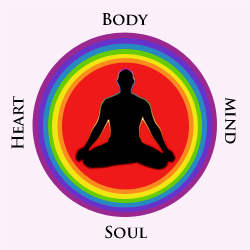 Susan Weed’s “six steps to healing” are a very important mindset to have for those who are into holistic treatment. They favor things that build you up overall, and not those that target specific symptoms, don’t look for the cause, and give you various side effects. Rather, you only delve into those treatments when everything else is exhausted. While there is a time for everything, there is also a great need for people to understand where the measures that they are taking, presumably to support their health, lay on a spectrum of something that “couldn’t hurt” to something that will, inevitably. Step 0-3 can be considered preventative medicine, whereas 4-6 would be implemented only to deal with something that was already happening.
Susan Weed’s “six steps to healing” are a very important mindset to have for those who are into holistic treatment. They favor things that build you up overall, and not those that target specific symptoms, don’t look for the cause, and give you various side effects. Rather, you only delve into those treatments when everything else is exhausted. While there is a time for everything, there is also a great need for people to understand where the measures that they are taking, presumably to support their health, lay on a spectrum of something that “couldn’t hurt” to something that will, inevitably. Step 0-3 can be considered preventative medicine, whereas 4-6 would be implemented only to deal with something that was already happening.
I certainly begin my own health journeys at step 0-1, and do recommend that other people do most of the time as well. Sometimes, even if it doesn’t fix our problems, we have a new understand of what the cause is and how best to go about healing ourselves.
Step 0) Yes, there is a step zero. It’s do nothing. Maybe you are thinking that that isn’t very healing, but consider that your problem could be something like a headache. Just wait it out, don’t worry about it, your body often deals with great feats. This step includes sleep, rest, meditation, and getting rid of stimulating distractions. Perhaps not all of your problems would be well suited to implementing step zero, but it can certainly be the ideal place to start (and perhaps even end) for many things.
Step 1) Collect information. Get a better idea of what you are dealing with. What else may be influencing this problem other than what you may already be thinking of? How do people go about healing themselves? What could be the cause? Could you join a support group?
Step 2) Engage the energy. This is going to be in a more mental/emotional/psychological realm. Thought patterns you need to change? Ways you need to live our your purpose or express yourself that you can’t or don’t feel capable of?
Step 3) Nourish and tonify. This is going to include eating well, physical activity, lifestyle changes, perhaps using nourishing herbs as infusions and vinegars. This tends to be where people really focus when they are trying to up the health in their life.
Step 4) Stimulate and sedate. Acupuncture, massage, some drugs (like alcohol or marijuana). There is a risk of dependency upon most of these substances, though they are relatively harmless on their own. For instance, if you have pain that you get acupuncture for, and then every time you have pain you get acupuncture because it worked the first time, you may be ignoring what the actual cause of the pain is, which could even be emotional in origin. This tends to be the step many people use (even those in the holistic framework) when they have a problem.
Step 5) Use drugs. These can include typical drugs people take on a daily basis, including hormonal drugs (like hormonal contraception – stop taking that junk!). For Susan Weed, this includes even vitamin and mineral supplements. These are things that may have unintended side effects, that may create other imbalances. Even if they do clear a symptom, they are generally not creating health.
Step 6) Break and enter. Surgery, invasive tests, colonics, etc. These are things that will definitely bring about side effects.
One reason I find these steps important in terms of hormonal health, is that often we embark upon fixing our hormonal health when it comes to infertility. If we start off on synthetic hormonal treatments we may end up giving our bodies and our babies adverse effects that are currently unknown. Though it is so difficult to go with slower treatments when we want to be pregnant (yesterday!), we can rest assured that we are building our health and if a pregnancy does result it will be all the more healthy.



